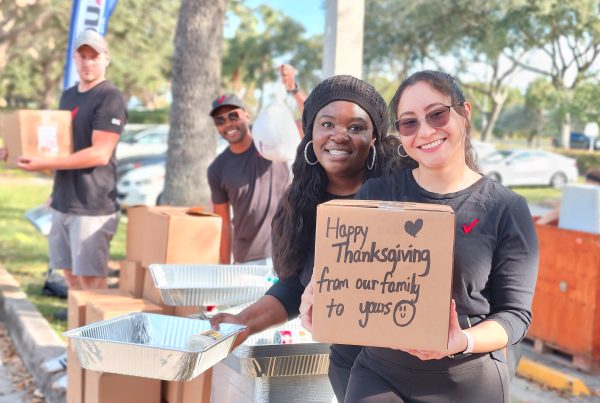With a crowd of more than 400 people cheering around them, Mayor Mort and Reilly scuttled across the warm powder-like sand of Juno Beach. As they drew closer to the ocean, the briny foam of the ocean teased their beaks.
With an abrupt toss of the waves—and roar of applause from the spectators—the loggerhead sea turtles were back in the their native underwater world. In the far distance toward the horizon, the surface of the churning Atlantic shimmered.

Sea turtle release by the Loggerhead Marinelife Center. Photo courtesy of the Loggerhead Marinelife Center.
The Valentine’s Day release of the pair may have ended with a short trot to the water, but it was a scuttle some time in the making—just months before both sea turtles were found sickly and on the verge of death.
Reilly, the smaller of the two, was found back in October in a power plant canal in St. Lucie county. The adolescent turtle had numerous barnacles embedded on its body, indications of prolonged inactivity due to anemia. Feeble and emaciated, veterinarians at the Loggerhead Marinelife Center in Juno Beach deemed Reilly to be chronically debilitated.
Mayor Mort, who was named in loving memory of Juno Beach’s late mayor, Mort Levine, was also discovered in St. Lucie. Mort, like Reilly, was lethargic and anemic, but unlike his younger counterpart didn’t just have barnacles (hundreds of them!) on his carapace, but also had leeches too.
Thousands of leech teeth were puncturing Mort’s shell, sucking blood. Heavy infestations of such organisms can be a death sentence for a sea turtle.
At the Loggerhead Center, both turtles were immersed in fresh water for the first few days of their stay, a treatment that causes many of the parasites to detach. Since neither seemed to have much of an appetite when they first arrived, they were given parenteral nutrition—intravenous sustenance—until they were able to eat again for themselves.

Mayor Mort in his “hospital room.” The black object on his back is the tracking system the center uses to chart his course in the wild. Photo courtesy of the Loggerhead Marinelife Center.
Slowly, over the course of many weeks, and with the added help of antibiotics and iron supplements, the pair began to show progress in their healing. When they were finally released earlier this month, Mayor Mort and Reilly became part of the dozens of sea turtles—like Betty White, Nemo, and Dory—that the Loggerhead Center successfully rehabilitated this past year.
The beach releases, which are free to attend, have become nothing short of a spectacle for many locals, such as Sarah McDonald, a student at Florida Atlantic University’s Honor’s College. She says that every release is an emotional experience for her.
“It’s exciting to follow [a sea turtle’s] whole story and road to recovery,” she says. “As a marine biology major, you learn a lot about the disruption that mankind can put on our oceans, so it’s a great feeling to see the other side of that: being able to help rather than harm the animal.”
Over the years the rehabilitation efforts have not only helped the turtles, but have also helped catapult the Loggerhead Center to local stardom. In 2016 alone the facility welcomed more than 300,000 visitors, many from around the world—that is as many as the Perez Art Museum receives annually!
As more people come to learn about the center’s mission to help marine animals (through e-blasts, social media channels, and news stories) the attendance of each release has steadily grown.
Hannah Deadman, a spokesperson for the marine life center, says that the large turnouts are a testament of the local community’s support for sea turtles and coastal environments.
As to why many of the observers of the releases are regulars, Deadman tells Boca Raton the reason she believes the events continue to be so popular: “Watching a wild animal return to its home never gets old!”
As for Mayor Mort and Reilly, the duo are expected to do well back in their aquamarine world. “Since we have medically cleared the turtles for release, we are hopeful that the turtles will do well in their wild ocean home—just as sea turtles should be,” Deadman says.
Mayor Mort was tagged with a satellite tracker before release so that biologists can see the turtle’s movements in the wild. If you’re interested in checking out how Mort is faring out in the open ocean, you can so do by visiting: www.marinelife.org/track.







